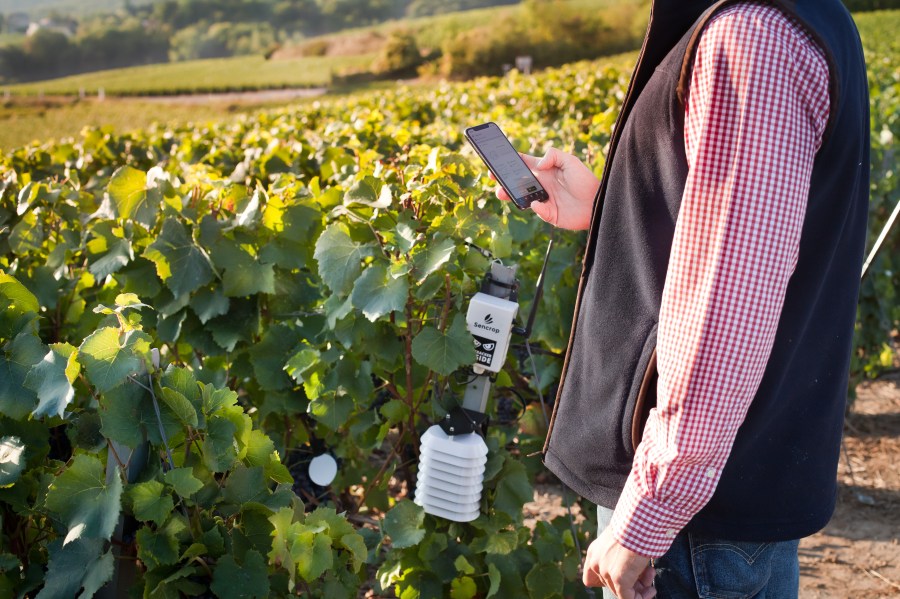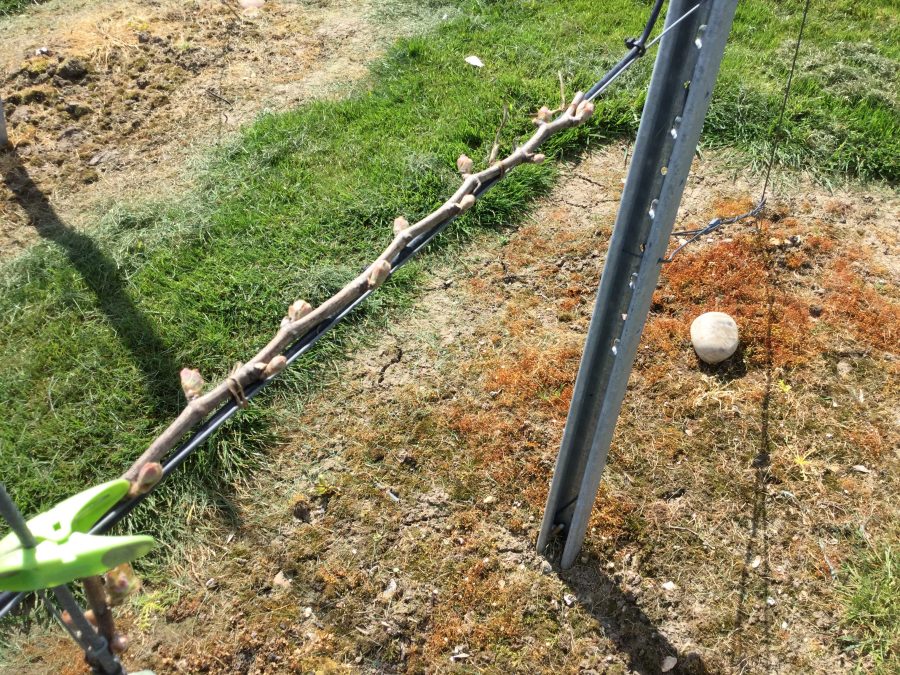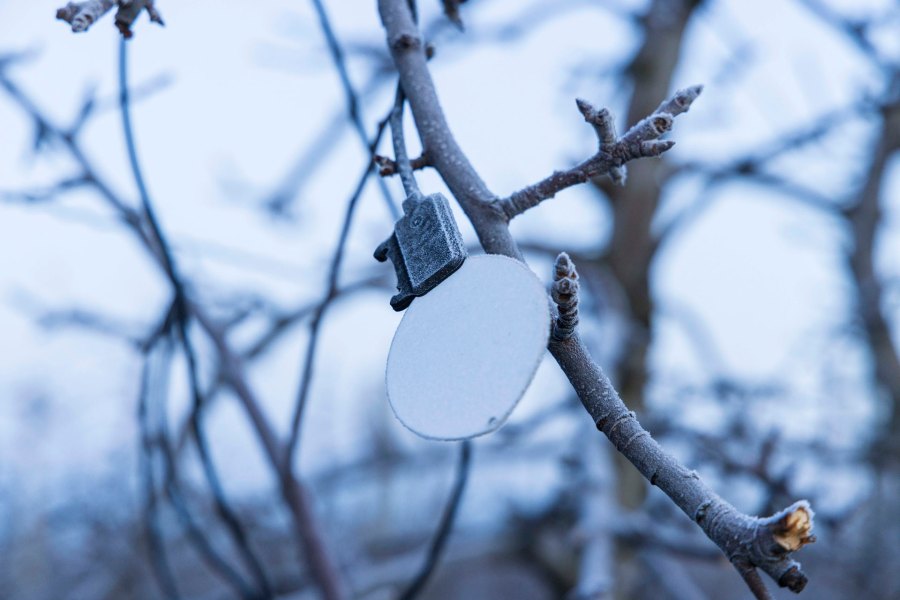Generally, frost protection methods are active or passive. An active method modifies the temperature of the vineyard to mitigate against the frost during a specific weather event. They might include heaters and bougies, sprinklers or wind machines.
Passive methods are the holistic decisions made as part of the wider management of the land that give the vines the best chance of being protected, or at least withstanding, the ravages of frost. These decisions start with the establishment of the vineyard – choosing the variety of vine to be planted and selecting the best site where pockets of frost will not gather. They also include optimising the soil’s capacity for water retention, use of cover crops and management of natural barriers to divert frost away from the vines.
Monitoring your vineyard
Precision monitoring is an important way of staying ahead of the game, because frost can be such a localised risk – varying from field to field. A weather station that is connected to an app can really help maintain an accurate picture across the property.
Sencrop
Sencrop recently talked me through their range of monitoring solutions. They offer precision weather stations connected to a collaborative weather application that enables farmers to monitor the weather conditions in their plots and simplify the day-to-day management of their farming operations, with indicators tailored to their plots.
The company offers ways to benefit from reliable weather live data and forecasts, to anticipate the risk of frost, to protect crops and to control irrigation. Anticipating frost accurately means that mitigation systems are only triggered when and where they are needed – making them both efficient and financially cost effective.
Sencrop’s weather station products include The Raincrop connected rain gauge, a station for measuring rainfall, temperature, humidity and dew point. And The Leafcrop connected humidity sensor: a station for measuring humidity, temperature, and dew point. This sensor simulates the natural characteristics of the leaf, enabling growers to obtain precise, reliable measurements right in the heart of their vineyards.
The Sencrop collaborative weather application gives users access to several features that are designed to assist with the battle against frost:
- They can anticipate future risks thanks to the weather forecast functions. Initially, users can follow the seven forecasting models or follow the Sencrop forecasts. Sencrop forecasts are the result of the creation of a unique algorithm. It compares the historical weather data from the stations with the forecasts given by various models, then automatically aggregates the best of each one according to the grower’s position, for an unprecedented level of accuracy. That being said, the most practical way of anticipating frost risks is to be able to compare the different forecasts on the same graph using the Sencrop frost module! Users themselves can compare the different forecast models over four days and identify extremes in forecast temperatures at a glance.
- Users can also activate pre-set frost alerts or create customised alerts to be notified when a certain temperature threshold (wet and dry) is reached. They can choose a notification method (call, SMS, email) and be alerted in real time to trigger control measures on time.
- Moreover, they can also monitor the weather conditions in their plots in real time, thanks to readings from their stations – updated every 15 minutes.
Ultra-local data is particularly relevant in the fight against frost, for weather conditions vary greatly from one vineyard to another, and depending on the topography of the plot, they might vary from the top to the bottom of the plot.

Frost protection without single-use materials
Heated wires
Active methods of frost protection do not necessarily have to be labour intensive during the weather event. Winding Wood Vineyard in West Berkshire installed heated wires in the spring of 2017. They have a cold site at 130m above sea level, so frost protection is essential. The system runs along the fruit wire and creates a halo of heat around the cane to protect the tender buds. Winding Wood installed the system themselves and had an electrician bring the power lines back to the fuse box.
A single phase power supply is sufficient for the system to operate, using very little electricity – akin to an electric shower. The wiring is the same type that is used for underfloor heating. It turns on automatically via a temperature sensor that can be set to the preferred level. Winding Wood set it to spring to life at zero degrees. The wires heat up to a maximum of 20°C, so as not to damage the buds.
Winding Wood’s co-proprietor, Christopher Cooke, wrote a blog about the installation back in 2017:
“In February we took the decision to sell off all our stock of bougies! High-risk strategy?
Hopefully, not. At Winding Wood Vineyard we have decided upon another frost protection system: heated wires. Having seen an experimental installation at Ridgeview in Sussex and read about heated wires being used in New Zealand’s cool climate vineyards to good effect, we decided last year to install the system along the fruiting wires of our Pinot Noir.
However last year, as our pinot buds were only at the woolly bud stage when the worst night of frost hit they were not at their most vulnerable so it was difficult to be empirically accurate about their effectiveness. In any case, we lost no buds that year which was encouraging.
“In March 2017 we took the plunge and installed the system in our Chardonnay field – this involved attaching 1,500 metres of cabling to the fruiting wire. Last year, with bougies as our only frost protection, the Chardonnay buds were pulverized. Of course, we are no longer spring chickens and resent getting up in the night to light bougies; and secondly, we are not convinced bougies work down to -5°C in advective frost conditions – even when they are set out at double the recommended rate per acre.
“How did our heated wires manage with the three Armageddon nights in April? Well, if you had asked us on the morning of 26 April I would have said confidently that they performed extremely well over two consecutive nights of -4.5°C conditions with minimal damage – maybe just 2% of bud losses. However, the third night of 26/27 April was a perfect storm: we had hail and rain in the early evening with northerly winds followed by -4.5°C temperatures over night and the conditions decimated our advanced buds. Clearly, the heated wires just could not cope with the freak combination of wet and freezing conditions. We estimate to have lost 70% of our primary buds which by the afternoon of 27 April resembled dried tobacco plants.
“Given the unusual conditions in April this year, everyone’s vines were ahead of normal – we had an average of three leaves out – and I wonder if our buds had been less advanced we would have been so badly affected. Without wanting to indulge in schadenfreude, it was interesting that other vineyards in this area, which employed no frost protection save spraying Frostec, were 100% wiped out. Whether the secondary bunches will be worth having only time will tell.”
Christopher’s experience of the system has generally been a positive one. The temperature sensor means that his vines are protected automatically, and the low energy use makes it cheap to run – although installing over a larger area would naturally lead to a higher upfront investment. Over the years no maintenance has been required, except when the wires are inadvertently cut while pruning, “which has happened on, mercifully, just three occasions.”

Sprinkler systems
Using low-flow sprinkler systems as a method of frost mitigation is effective as it creates a microclimate around the vines because the water being sprayed is at a higher temperature than the air. That water then freezes, creating a thin layer of ice around the plants, which in turn produces latent heat. This ice layer creates a barrier around the plant. Since it is continuously freezing as long as water is being sprayed, the exothermic reaction continues ensuring protection for the inner cells of the buds.
Professional systems are available which can produce a cost-effective and sustainable answer to the frost question in the long term as the materials have a long life span. The sprinklers can be targeted to the areas that are most at risk, making them an efficient solution.
However, for the smallest producers, this may still be a capital investment too far. Martin Jones of Jones’ Colehurst Vineyards in Shropshire has taken a DIY approach to his sprinkler system. The area that needs protection is relatively small, a 4.5-hectare plot. The vineyard is in a slight valley where the frost moves through slowly, so the vines at the top tend to avoid the worst. Efforts must be concentrated on those at the bottom that take the worst of the damage.
Martin has been able to improvise a solution by connecting his sprayer to a gas burner to heat the water. In the middle of the night, he drives up and down the rows, spraying warm water on the vines, which is the best solution he has found for his property, even in light winds.
Delayed winter pruning
Since dormant buds are more resistant to frost damage than new green shoots, delaying bud development will offer the best chance to survive through late bursts of cold. Since the buds furthest from the crown will burst first, leaving pruning until late can help to protect the remaining buds closer to the trunk that you want to keep.
The most practical way of doing this might be leaving sacrificial canes. Trim and tie the primary canes in the usual way, perhaps leaving them a little longer. Then leave your chosen spurs as extra long, standing canes. After the danger of frost has passed, the sacrificial canes can be removed.
Government support
The Sustainable Farming Incentive (SFI) rewards farmers for practices that help to protect the environment and produce sustainable crops. It is intended to support business resilience to protect agriculture in both the long and short term. This includes improving soil health and mitigating the impact of extreme weather.
The SFI includes actions like adding organic matter to soil and reducing bare ground.
In terms of frost protection, improving soil health is a positive and sustainable way of mitigating the damage frost can cause.
Water holding capacity
Adequate soil moisture acts as a thermal barrier, absorbing and releasing heat slowly, which can moderate temperature fluctuations in the vineyard.
Cover crops and mulch
Cover crops can provide insulation, reducing the speed at which temperatures drop in the vineyard and thereby minimising the risk of frost damage.
Nutrient levels
Balanced soil nutrient levels contribute to overall vine health. Properly nourished vines are better equipped to recover from stress, including the damage caused by frost.
Soil structure
Soil structure affects water infiltration and root penetration. Well-structured soils allow for good water movement and root development. A healthy vineyard ecosystem can have a positive impact on a vine’s ability to cope with frost events.
Speaking to Vineyard, a spokesperson for the Department for Environment, Food and Rural Affairs (DEFRA) said: “The Sustainable Farming Incentive has a range of actions that can be applied to UK vineyards, including soil health, pest management, enhanced nutrient management and increasing flower mix to support local wildlife. We encourage everyone to take a look at what the scheme can offer their business and get involved.”
There are ten actions applicable to UK vineyards under SFI. They include options to improve soil health, implement an integrated pest management plan, enhance nutrient management and foster farmland wildlife. There is also flexibility within the action IPM2 ‘Flower rich grass margin, blocks or infield strip’ which can be located in the alleyways between vines, using species selected which deliver IPM benefits.
The SFI is open for online applications now. Visit farming.campaign.gov.uk for full details of the scheme, including the eligibility criteria and guidance on how to apply.
Farming innovation programme
The government is also supporting vineyard managers through the farming innovation programme. Details are available at
www.farminginnovation.ukri.org. One of the successful applicants under the scheme is Outfield Technologies, which has been given funding to develop its VISTA system to generate integrated precision farming systems for vineyard production.
Outfield Technologies CEO and co-founder Oli Hilbourne said: “The VISTA Project is a great example of the strength of UK innovation funding, bringing together technology companies, growers and academic partners to solve specific industry challenges. The UK’s wine industry is growing rapidly, learning best practice from other wine growing regions. With VISTA, the UK wine industry has an opportunity to set the international standard and export our knowledge to the rest of the wine growing world. We are really excited to get started on the project and work with UK vineyards to drive productivity increases.”
| Code | SFI Action | Payment Rate |
| Soils | ||
| SAM1 | Assess soil, test soil organic matter and produce a plan | £5.80 per ha
plus £95 per agreement |
| Integrated Pest Management | ||
| IPM1 | Assess integrated pest management and produce a plan | £989 per year
(agreement level) |
| IPM2 | Flower-rich grass margins, blocks, or infield strip | £673 per ha |
| IPM3 | Companion crop on arable and horticultural land | £55 per ha |
| IPM4 | No use of insecticide on arable crops and permanent crops | £45 per ha |
| Nutrient Management | ||
| NUM1 | Assess nutrient management and produce a review report | £589 per year
(agreement level) |
| Actions for farmland wildlife | ||
| AHL1 | Pollen and nectar flower mix | £614 per ha |
| AHL2 | Winter bird food on arable and horticultural land | £732 per ha |
| AHL3 | Grassy field corners and blocks | £590 per ha |
| AHL4 | 4m to 12m grass buffer strip on arable and horticultural land | £451 per ha |




